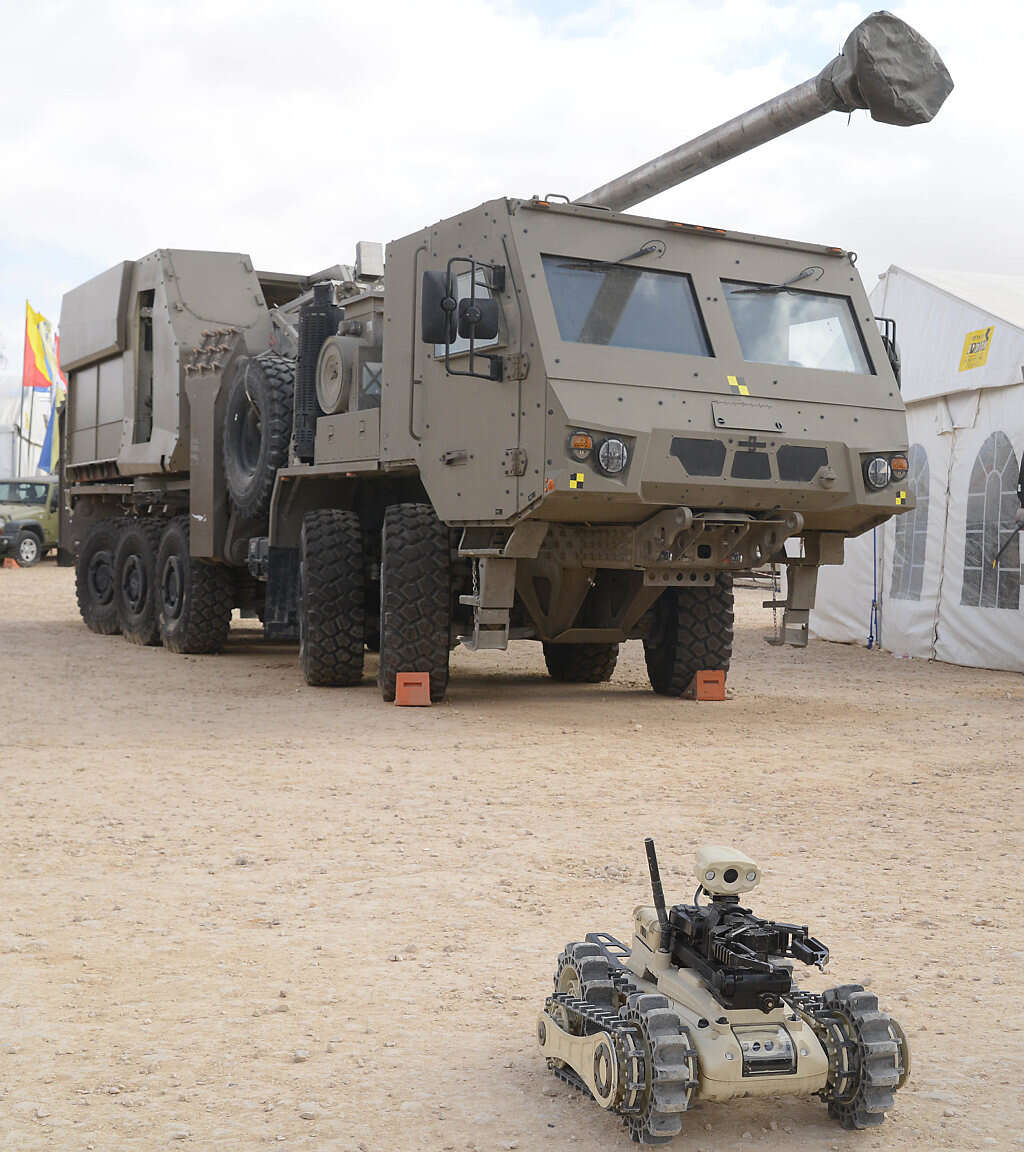For the first time in decades, the IDF Artillery Corps is now about to upgrade its outdated inventory of SPGs (Self-Propelled Guns) and will begin to phase into service the new Israeli SPG, the Ro'em ("Thundermaker") manufactured by Elbit Systems. Israel Hayom was afforded an initial glimpse of this new weapon system, currently in the final stages of its development, and which is scheduled to become one of the most lethal tools in service with the IDF.
Follow Israel Hayom on Facebook, Twitter, and Instagram
"This is more than a generation leap it's a multi-generation leap forward," proudly announces IDF Chief Artillery Officer Brig. Gen. Nerry Horovitz, next to the initial prototype of the Ro'em at the Shivta artillery base in the Negev desert. The IDF's current SPG, known as the Doher (galloper), is essentially the US-made M-109 howitzer developed in the 1960s, some of whose systems have subsequently been upgraded. Naturally, even if they undergo optimal maintenance treatment, the current state of these legacy systems is well past its prime.
For at least twenty years, if not more, the Artillery Corps has been asking to replace these obsolete SPGs, but the plans were repeatedly shelved in favor of allocating these resources to the Israel Air Force and for other urgent needs. The war in Ukraine, in which artillery has proven to be the most dominant factor on the battlefield, has provided an unexpected source of support for the decision to upgrade the IDF's fleet of howitzers.
In contrast to the Doher, which is mounted on a caterpillar track giving it a tank-like appearance, the Ro'em uses the chassis of a giant Oshkosh truck with 10X10 drive, giving it a rather intimidating appearance. The use of a wheel-driven rather than a track-driven system enables rapid mobility between combat fronts, obviating the need for tank transporters, while both simplifying the vehicle's maintenance and rendering it far less expensive.
Each individual Ro'em is capable of generating a volume of firepower almost equivalent to that of an entire battery of Doher SPGs. To illustrate this comparison, the real fire fate of a Doher has remained stable at two shells per minute, while the Ro'em is capable of firing eight shells per minute. This fire rate, which only a limited number of howitzers in the world are capable of producing, is attained thanks to the completely automatic and computerized loading system. The familiar image of the sweating, fatigued loader, breaking his back to bend down and lift shells weighing dozens of kilos, is soon to become a thing of the past.
Will women be able to serve in the Ro'em?
This fact might open up the combat positions in the Ro'em for women too, as in the past the heavy weight of the shells was the main barrier preventing their integration within the IDF's current SPGs. "Today, women are integrated in all the Artillery Corps units – including in the SPG battery command vehicles, even if they do not serve in the Doher SPGs themselves, stresses Brig. Gen. Horovitz, and duly adds: "As far as I am concerned, there is no reason to prevent women from serving as combat soldiers in the new Ro'em systems."

In practice, the Ro'em's practical fire rate can reach up to several shells per second, in a focused volley. This exceptional capability is attained by the integration of cutting-edge technology known as MRSI (Multiple Rounds Simultaneous Impact) in the vehicle's fire computer.
Video: A visit to an IDF artillery base / Yaniv Zohar
Without blinding you with the minute technical details, in essence, the Ro'em alters the barrel angle and the size of the propellant charge that propels the projectiles, causing them to reach the target and hit it simultaneously. This is a significant capability as the first shell, which hits the target before the enemy has had the chance to take cover, has the greatest lethal potential. A battery of Ro'em SPGs would be able to fire a burst of dozens of shells with precision timing of a single second at a surprised and exposed enemy.
If that isn't sufficient, then the Ro'em's range is almost double that of the IDF's current SPGs, reaching targets at a distance of 40 km. In contrast, the Ro'em is much more economical as it requires a considerably smaller crew of three (male or female) soldiers alone, compared with the seven-man crew needed to operate the Doher.
In addition, the Ro'em is a vehicle that enjoys absolute independence in the field. It is not dependent on a separate fire computer, which is currently located in the battery command vehicle but is equipped with its own computer. "This particular feature affords us maximum flexibility and enables us to operate the Ro'em SPGs in any combat formation we wish, starting with the single howitzer," remarks Horovitz.

Our visit to Shivta took place in parallel to an event organized by the Be'ikvot Lohamim ("in the footsteps of warriors") project – a one-day event organized by the IDF Ground Forces Command for high school students with a view to their upcoming military service, providing the various branches of the military with an opportunity to showcase their weapon systems and capabilities. "With all due respect to technology, the Artillery Corps' main weapon has been and always will be our amazing soldiers," proudly claims Brig. Gen. Horovitz.
Video: The Ro'em SPG in action / Elbit
"In fact, for some time now we have been much more than a corps of artillery guns, so our name is slightly misleading. Our corps is a technology-intensive entity composed of a variety of units such as the drone units, the rocket units, and the PGM (precision-guided munitions) units, which together provide the IDF with the spearhead of its land-based firepower. The soldiers, both male and female, who operate these systems, along with the SPG units, are required to excel in the field of technological literacy, and thankfully they are doing a great job."
Subscribe to Israel Hayom's daily newsletter and never miss our top stories!




